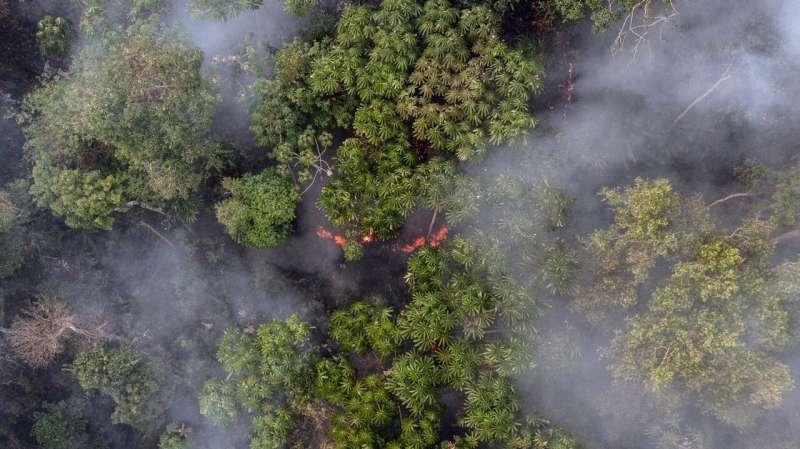This article has been reviewed according to Science X's editorial process and policies. Editors have highlighted the following attributes while ensuring the content's credibility:
fact-checked
trusted source
proofread
'Heroes in the fire': Scientists' film shows the reality of firefighting in the Amazon

The heroic efforts of local firefighters tackling wildfires in the Amazon rainforest has been documented through a new short film commissioned by leading environmental scientists.
Featuring dramatic on the ground scenes of fire fighters on the frontline in the battle to save areas of Amazon rainforest from destructive wildfires, "Heroes in the fire: the struggle of local brigades in the Amazon" shines a spotlight on small teams of fire brigades.
The film features local people that make up the brigades working long hours in oppressive conditions, and highlights some of the tactics they use to tackle runaway blazes that threaten large areas of the world's largest rainforest.
The film was created by an international team of scientists that have been studying the Tapajos region of the Amazon rainforest, including its ecology and the impacts of fires for biodiversity and carbon emissions, since 2010.
During their research they witnessed first-hand the efforts of the brigades and wanted to tell their story.
"On a personal level, for me the motivation to do the film is my immense admiration towards these men," said Dr. Erika Berenguer, of Lancaster University and the Environmental Change Institute at the University of Oxford.
"They were putting their own bodies at risk, I saw a burning log falling on the head of one of them, I saw them working without water to drink, I saw them exhausted and dirty but continuing non-stop; all this to avoid the burning of the Amazon.
"During the combat, one of them died while driving on a road with poor visibility due to smoke. Their stories are never told, but they were the protagonists of this fight."
The film reveals how the brigades use labor-intensive tactics such as fire breaks—2-meter-wide corridors scraped into the forest floor where all vegetation, such as plants and leaf litter, is removed using hand tools and leaf blowers. The idea is to starve the advancing flames of fuel, halting its progress and protecting the forest behind the break.
Dr. Berenguer appears within the film to explain how preliminary data is showing that the work of the local brigades, as well as rain, helped to reduce the area of forest damaged by wildfires in 2023.
"Without the efforts of the fire brigades, who are working in high temperatures and exposed to smoke inhalation, much larger areas of the forest, one of the most biodiverse forests on Earth, would become damaged by fire," said Dr. Berenguer.
"The Amazon should not burn, and when it does the fires change the composition of the forest, which is relied on by local people to survive, impact biodiversity but also cause significant carbon emissions."
Scientists within the film, including Dr. Joice Ferreira of Embrapa in Brazil, explain that deforestation is one of the main causes of forest fires in the Amazon, as fire is used as a way of clearing the land. And once a forest has burned once, it increases the risks of further forest fires.
Dr. Ferreira said, "When forests have been damaged by fires, that leaves them more vulnerable to more intense fires that burn much more rapidly as there is more fuel in the form of dead trees killed by previous blazes. And a more open canopy allows more air in to further fan the flames."
The scientists have noticed changes in the fires over the 14 years they have been visiting the region.
"The fires are changing. Last year they were more intense than when we visited in 2015," said Dr. Berenguer. "Back then flames were only 30 cm in height, burning slowly across the forest floor. This time flames were reaching 15–20 meters in certain places. This has completely changed the dynamic of the combat for the fire fighters."
Professor Jos Barlow of Lancaster University commissioned the video because he felt it is important for policy makers in Brazil, and the general public, to see the difficulty and the critical nature of the work undertaken by the fire brigades.
"We decided to make the film when we were talking to firefighters in December 2023—they were telling us about their experiences and showing us their videos, and it was clear their story needed to be told," said Professor Barlow.
"We wanted to let the local firefighters and residents tell their story, reaching a broad audience including government bodies, people involved in planning and funding fire-fighting activities, as well as the general public. The aim was to help attract attention to the problem, some of the techniques they use that are most effective, and the importance of their actions."
However, despite the heroic actions of the fire brigades, the scientists caution that the best defense against forest fires is prevention.
"It's much more efficient to prevent rather than fight fires," said Dr. Ferreira. "Unfortunately this is not currently the case in the Amazon where the emphasis is on fighting fires, and very little on prevention."
Provided by Lancaster University




















